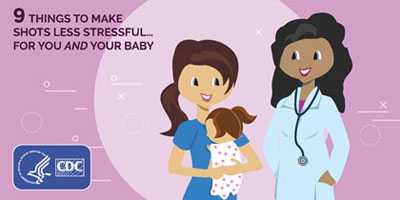Your Child’s Vaccine Visit
There are things that parents can do before, during and after vaccine visits to make them easier and less stressful.
Before the Visit
Come prepared! Take these steps before your child gets a shot to help make the immunization visit less stressful on you both.
- Read any vaccine materials you received from your child’s healthcare professional and write down any questions you may have.
- Use this Instant Childhood Immunization Schedule tool to see which shots are recommended for your child's age.
- Learn more about the benefits and risks of the vaccines that your child will receive by reviewing Vaccine Information Statements. You can also request Vaccine Information Statements at the doctor’s office.
- Find your child’s personal immunization record and bring it to your appointment. An up-to-date record tells your doctor exactly what shots your child has already received.
- Pack a favorite toy or book, and a blanket that your child uses regularly to comfort your child.
- A mild illness is usually not a reason to reschedule a vaccination visit. Learn more about vaccines when your child is sick.
For older children
- Be honest with your child. Explain that shots can pinch or sting, but that it won’t hurt for long.
- Engage other family members, especially older siblings, to support your child.
- Avoid telling scary stories or making threats about shots.
- Remind children that vaccines can keep them healthy.
At the Doctor's Office
If you have questions about immunizations, ask your child’s doctor or nurse. Your child’s doctor will give you Vaccine Information Statements (VIS) for the shots that your child will be getting that day. VIS include information about the risks and benefits of each vaccine. If your doctor doesn’t give you one you can request one.
For babies and younger children
Try these ideas for making the shots easier on your child.
- Distract and comfort your child by cuddling, singing, or talking softly.
- Smile and make eye contact with your child. Let your child know that everything is ok.
- Comfort your child with a favorite toy or book. A blanket that smells familiar will help your child feel more comfortable.
- Hold your child firmly on your lap, whenever possible. Learn more about how to hold your child during shots.
Once your child has received all of the shots, be especially supportive. Try these tips for soothing your baby:
- Swaddling
- Skin-to-skin contact
- Offering a sweet beverage, like juice (when the child is older than 6 months)
- Breastfeeding
For older children and adolescents
- Take deep breaths with your child to help "blow out" the pain.
- Point out interesting things in the room to help create distractions.
- Tell or read stories.
- Support your child if he or she cries. Never scold a child for not "being brave."
Fainting (syncope) can be common among adolescents immediately after getting shots. To help prevent any injuries that could occur from a fall while fainting, your preteen or teen should stay seated for 15 minutes after the shot. Learn more about fainting.
Before you leave the appointment, ask your child’s doctor for advice on using non-aspirin pain reliever and other steps you can take at home to comfort your child.
After the Shots
Sometimes children experience mild reactions from vaccines, such as pain at the injection site, a rash or a fever. These reactions are normal and will soon go away. The following tips will help you identify and minimize mild side effects.
- Review any information your doctor gives you about the shots, especially the Vaccine Information Statements or other sheets that outline which side effects might be expected.
- Use a cool, wet cloth to reduce redness, soreness, and swelling in the place where the shot was given.
- Reduce any fever with a cool sponge bath. If your doctor approves, give non-aspirin pain reliever.
- Give your child lots of liquid. It’s normal for some children to eat less during the 24 hours after getting vaccines.
- Pay extra attention to your child for a few days. If you see something that concerns you, call your doctor.
Finding and Paying for Vaccines
Most health insurance plans cover the cost of vaccines, but you may want to check with your insurance provider before going to the doctor to see what is covered under your plan.
If you don't have health insurance, or your plan does not cover vaccines, the Vaccines for Children (VFC) program may be able to help. This program provides vaccines at no cost to over 42,000 health care professionals who serve eligible children. Children younger than 19 years of age are eligible for VFC vaccines if they are Medicaid-eligible, American Indian or Alaska Native or have no health insurance.
Parents of uninsured children who receive vaccines at no cost through the VFC Program should check with their doctor about possible vaccine administration fees that might apply. The administration fees help providers cover the costs that result from important services like storing the vaccines and paying staff members to give vaccines to patients.
To learn more about the VFC program, visit the VFC program website.
Consult this list of VFC Coordinators.
Learn more about Medicaid in your state.
You can also check with your local health department to see if they have a public health clinic. Many public health clinics offer free vaccines to those eligible through the Vaccines for Children program.
- Page last reviewed: April 15, 2016
- Page last updated: August 5, 2016
- Content source:


 ShareCompartir
ShareCompartir
